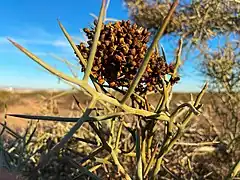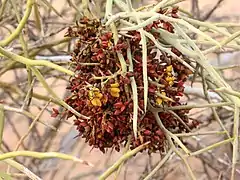Castela emoryi
Castela emoryi, with the common names crucifixion thorn, Emory's crucifixion-thorn, and Spanish: chaparro amargosa,[2] is a shrub species in the genus Castela of the family Simaroubaceae.[3]
| Castela emoryi | |
|---|---|
 | |
| Castela emoryi | |
| Scientific classification | |
| Kingdom: | Plantae |
| Clade: | Tracheophytes |
| Clade: | Angiosperms |
| Clade: | Eudicots |
| Clade: | Rosids |
| Order: | Sapindales |
| Family: | Simaroubaceae |
| Genus: | Castela |
| Species: | C. emoryi |
| Binomial name | |
| Castela emoryi | |
| Synonyms | |
|
Holacantha emoryi A. Gray | |
Distribution
The plant is native to the Mojave Desert and Sonoran Deserts of North America.
It is found in southern California, Arizona, and Sonora state (México).[3]
The species is dioecious and occurs in the moistest areas in the hottest, driest deserts within its range; it is considered poor in germination.[4]
Description
Castela emoryi is often less than 1 metre (3.3 ft), and occasionally to grows 4 metres (13 ft) or more.[5]
Crucifixion thorn is mostly leafless,[6] [4] its sharp branches are green and perform photosynthesis.[7] Seeds are contained in clusters of fruit in groups of 5. The fruit is tan, green, red or brown in color, turning black with age. and may persist on the tree for several years.[8]
It is ranked on the California Native Plant Society Inventory of Rare and Endangered Plants, as an endangered species within California, and more common elsewhere.[9] It is threatened by solar energy development and military activities within its California range.[9] The species is classified as "Salvage restricted" in Arizona.[2] [10]
 green thorns
green thorns fruit cluster
fruit cluster
Ecology
Castela emoryi is one of the few plants in its habitat that blooms in the mid-summer heat, and serves as an important source of resources for insects during that time. Its nectar is collected by ants, and pollination is performed by wasps and bees, [2] particularly bumblebees. [11]
Uses
The Yavapai people traditionally used this as a medicinal plant, making a dermatological aid from its bud's sap.[12]
Insecticide and fungicide
Castela emoryi is a plant toxin insecticide. It contains quassinoids such as glaucarubolone glucoside which has antifeedant properties against termites such as Reticulitermes flavipes,[13] or potential fungicidal activity for the control of grape downy mildew.[14]
It also contains glaucarubol, a compound characteristic of the family, ellagic acid, betulin and (—)-syringaresinol.[15]
References
- "NatureServe Explorer 2.0". explorer.natureserve.org. Retrieved 13 April 2023.
- "Chaparro – Castela emoryi". United Plant Savers.
- "Castela emoryi EMORY'S CRUCIFIXION-THORN". Jepson Herbarium.
- "Castela emoryi Crucifixion-thorn". NatureServe.
- CalFlora: Castela emoryi
- "crucifixion thorn Simaroubaceae Castela emoryi (A. Gray) Moran & Felger". Virginia Tech Dept. of Forest Resources and Environmental Conservation.
- "The Crucifixion Thorn Chaparro Amargosa Castela emoryi". DesertUSA.
- "Castela emoryi". Lady Bird Johnson Wildflower Center.
- California Native Plant Society−CNPS, Inventory of Rare and Endangered Plants: Castela emoryi . accessed 9.9.2015.
- "Protected Arizona Native Plants". Arizona Department of Agriculture.
- "Castela emoryi, Crucifixion Thorn". Southwest Desert Flora. Retrieved Dec 10, 2022.
- University of Michigan at Dearborn: Native American Ethnobotany for Castela emoryi
- Antifeedant properties of natural products from Parthenium argentatum, Parthenium argentatum, ×Parthenium tomentosum (Asteraceae) and Castela emoryi (Simaroubeaceae) against Reticulitermes flavipes. Carmen Gutiérrez, Azucena Gonzalez-Coloma and Joseph J. Hoffmann, Industrial Crops and Products, Volume 10, Issue 1, June 1999, Pages 35–40, doi:10.1016/S0926-6690(99)00003-5
- Glaucarubolone glucoside, a potential fungicidal agent for the control of grape downy mildew. Joseph J. Hoffmann, Shivanand D. Jolad, Louis K. Hutter, Steven P. McLaughlin, Steven D. Savage, Scott D. Cunningham, Jean Luc. Genet and George R. Ramsey, J. Agric. Food Chem., 1992, 40 (6), pages 1056–1057, doi:10.1021/jf00018a029
- Constituents of holacantha emoryi. W. Stöcklin, L.B. De Silva and T.A. Geissman, Phytochemistry, Volume 8, Issue 8, August 1969, Pages 1565–1569, doi:10.1016/S0031-9422(00)85931-2
External links
 Media related to Castela emoryi at Wikimedia Commons
Media related to Castela emoryi at Wikimedia Commons Data related to Castela emoryi at Wikispecies
Data related to Castela emoryi at Wikispecies- CalFlora Database: Castela emoryi (Cricifixion Thorn)
- Jepson Flora Project treatment of Castela emoryi
- UC Photos gallery — Castela emoryi
